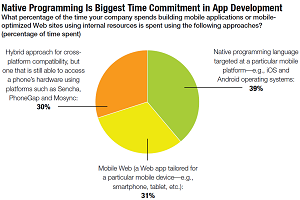News
Mobile Survey: Native Development, Back End Take Most Time
- By David Ramel
- August 5, 2014
A new survey shows mobile app developers spend most of their time building native apps and that back-end coding takes up far more time than building the front-end UI.
Sponsored by Oracle Corp., the survey found almost no consensus among enterprises about the development approach used to build apps, with little difference among the native, Web-based cross-platform and hybrid cross-platform techniques.
Native development -- targeting one platform such as iOS, Android or Windows Phone with separate projects -- had a slight edge, taking up 39 percent of respondents' time devoted to actual coding. In the cross-platform camp, Web-based and hybrid approaches were just about equal, taking up 31 percent and 30 percent of the developers' time, respectively.
Regardless of the approach, back-end integration was reported as a major time sink. While 29 percent of development time was devoted to front-end development, back-end work like integration, security, quality assurance testing and design took up more than 70 percent of the developer's time.
The survey, conducted by CIO Strategic Marketing Services and Triangle Publishing Services at the behest of Oracle and titled "The Connected Enterprise: Keeping Pace with Mobile Development," polled 414 responses from executives in enterprises familiar with mobility and app development.
 [Click on image for larger view.]
Little consensus on the native vs. cross-platform approach question.
[Click on image for larger view.]
Little consensus on the native vs. cross-platform approach question.
(source: Oracle Corp.)
"Although the survey results show a high commitment to mobility, they also show little consensus about methods of mobile development and deployment, whether across industries or across geographies," the accompanying white paper supplied by Oracle stated. "The survey reveals splits in commitment to internal development versus external development versus outright purchasing of third-party mobile applications, as well as splits between the development of native applications and cross-platform, browser-based applications. The cost and complexity of integrating mobile applications with back-end systems—in addition to maintaining security in accessing those systems—continue to be issues, as well."
On the native vs. Web vs. hybrid question, the report stated that even though the native approach is leading now, cross-platform tools have advantages that may turn the tide toward that approach in the future. "It's better to have a tool that lets you develop once and write to multiple platforms," the report quoted Patrick Sullivan at consultancy firm Accenture as saying. "For enterprise mobility, a hybrid tool is more than good enough." The report noted that the increasing number of development tools on the market was itself frustrating developers.
The survey also found that the time-consuming back-end integration work such as connecting to data sources was a key challenge as it entailed integrating the mobile app into a complex business process. More than one-quarter of enterprise mobile apps are integrated with back-end systems, the report found. Those systems consisted mostly of traditional applications like customer relationship management (CRM), e-commerce and enterprise resource planning (ERP).
As with most such surveys, security continued to be the primary concern for enterprise-wide adoption of mobile apps, and accommodating the burgeoning bring your own device (BYOD) trend added to that concert. Some 93 percent of respondents expressed concern over data loss and other security problems such as breaches with their mobile apps, and BYOD was a prime factor in that concern.
Other survey results included:
- The cadence of mobile app release cycles is increasing, as 35 percent of midsize and large organizations update their mobile portfolios on a monthly basis, with 34 percent doing so quarterly. A big majority -- 82 percent -- believed those rates would increase in the next couple years.
- External customers, rather than internal, were the main targets of development, with the breakdown thus: external customers, 34 percent; employees, 27 percent; executives, 24 percent; and suppliers, 15 percent. That trend is also expected to increase in the future.
- Some 44 percent of respondents said their organizations' app portfolios were internally developed rather than done by third parties.
- Cloud computing is important to mobile app development, as 75 percent of respondents said cloud services or hybrid clouds were "somewhat" or "very" important.
"Mobility has been ubiquitous for a while but only 10 percent of enterprises have an enterprise-wide deployment of mobile," concluded Oracle exec Suhas Uliyar. "Its impact and importance are gaining importance today. This survey is reassuring in that enterprises see potential for great payoff from making a strong mobile commitment. They are recognizing that mobile applications provide a new way to develop and maintain relationships with customers."
About the Author
David Ramel is an editor and writer for Converge360.